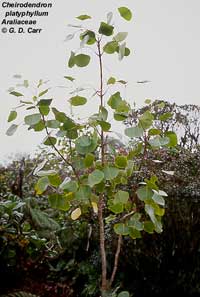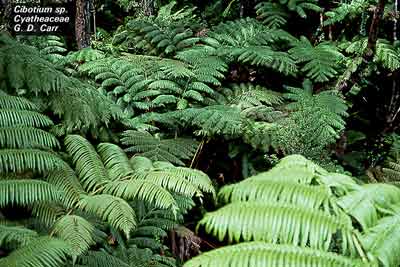|
|
|
|
|
|
|
|
|
|
|
|
| High elevation and more
than 100 inches of rainfall a year are the physical ingredients
for the wet forest, or wao akua.
These would have been the most common native plants in that
ecosystem: |
|
Wet
Forest uses
plant photos courtesy of the UH Botany Dept. Descriptive text
is taken from How to Plant a Native Hawaiian Garden - an
on line handbook. It also relies on Feathered Gods and
Fishhooks by Patrick V. Kirch. |
|
|
|
|
|
|
 |
 |
| Hame - endemic |
|
| 'Ohi'a Lehua
- `Ohi`a lehua wood is extremely hard, reddish, takes a fine
polish but is difficult to cure. Hawaiians used the wood for
tools, weapons and images. Endemic to all the main islands except
Kaho`olawe and Ni`ihau. |
|
|
|
|
 |
|
 |
|
| Olapa -endemic.
The leaves of the olapa move gracefully with the slightest breeze,
like hula dancers. |
|
|
Ho'awa - eight different endemic
species. |
|
|
|
|
|
|
 |
|
 |
|
Loulu - A total of 19 loulu
have been tentatively identified as endemic to the Hawaiian
Islands. |
|
|
|
|
| 'Ohe - one of
five endemic species. |
|
|
|
|
|
|
|
|
|
|
|
|
 |
Hapu'u - the
most common endemic tree fern in Hawai`i. Found on most islands
in semi-dry to wet forests, it is most conspicuous on Hawai`i
where it grows in close association with `Ohi`a lehua.
During ancient times, pulu (tree-fern silk) was used
for dressing wounds and for embalming. The starchy centers of
hapu'u trunks, cooked in the imu (earth oven), are famine
food. |
|
|
|
The animals that successfully dispersed
to the ahupua'a of Nawiliwili Bay began their adaptive radiation
(changing to survive different ecosystems) in the kaha
kai (coastal zone), the kula
(lowland dry and
mesic forest), and the wao akua
(wet forest). They became the native
animals of this area. |
|
|
|
|
|
|
|
|
|
|
|
|
|
|

